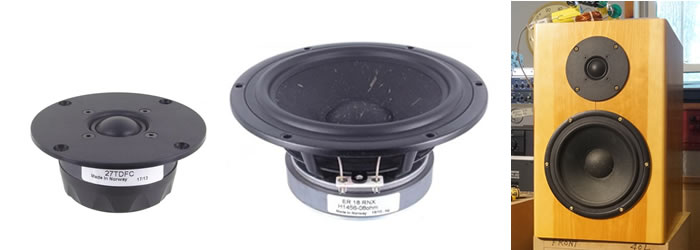Starling RevisitedWhen I first worked on the Starling, it was way back in 2010. I remember distinctly that the Seas ER18RNX woofer was quite a challenge then. Today, I decided to take another look at this expensive, highly rated woofer from Seas. Seas ER18RNX RAW Frequency Response The Black plot is the RAW response of the ER18RNX installed in a 15 liters bass reflex box with a baffle width of 8.5″. It reveals two main issues with this woofer. First, an astonishingly high mid-range starting at 500Hz. Normally, baffle step is about +3dB but this is double, at +6dB. The next problem is a cone breakup, resulting with a +10dB peak at 5kHz. Mind you, this is a 6.5″ woofer by Seas that retails for about $100. One would think that for that amount of money, they would do a better job. Taming the Shrew After numerous attempts, I managed to shape the ER18 the way I wanted. The Blue plot in Fig 2 is with a Notch network in place, followed by a 2nd order electrical filter adjusted to suppress the 5kHz peak down to -18dB. Crossing over to the 27FDFC tweeter Now that the ER18 is more behaved, it’s time to integrate in the tweeter. The Red plot in Fig 3 is one of my favorites, a Seas 27TDFC. The tweeter’s response is not as smooth as I would like it to be. The damaging effects of Baffle Edge Diffraction is unavoidable when using a dome tweeter. Perhaps I will replace it with a horn in future versions but for the time being, I will stick with the 27TDFC. Starling-II Frequency Response Fig 4 is the Frequency Response of the Starling-II. The 27TDFC tweeter integrated well. I am encouraged to see there are no nasty peaks or nulls along the way. Starling-II Reversed Null Response The Violet plot in Fig 5 is with the 27TDFC tweeter wired in Reversed Phase. A beautiful notch is produced with the tip at 3kHz. This is exactly where the ER18RNX and the 27TDFC crossed in Fig 3. Starling-II Harmonic Distortion The Starling-II harmonic distortion in Fig 6 is slightly lower than normal. In the vocal range, it registers about -55dB below the fundamental. From 1kHz to 10kHz, the harmonic distortion is very linear, averaging -50dB. |
the Sound of Starling-IISound wise, this version is much smoother than the first Starling. This is due mainly to the stronger suppression of the 5kHz peak of the ER18 and the manner in which the 27TDFC tweeter is integrated in. On playback, it is apparent that the mid-range is in a class of it’s own. Vocal clarity is stunning. Absolutely transparent. No other woofers in my disposable has mid-range that comes close. Unbelievable. From a 6.5″ mid-woofer at that. The Starling-II is best used in Half Space environment. In Full Space, bass is not as loud as I would like it to be. Once I support it with a Bandpass Sub, it sounds perfect, particularly for music with bass tracks. If you prefer to listen more to vocals, the Starling-II can be used without Subs. Is the Starling-II worth the costYes, it is. The Starling-II is for listeners that demand mid-range clarity above all else. It is so revealing that all the nuances in the recording can be heard. Admittedly, this may not be everybody’s taste. However, for audiophiles, music through the Starling-II is paradise. |

October 16, 2017Projects
 Fig 1 – Measurements below 500Hz are Nearfield
Fig 1 – Measurements below 500Hz are Nearfield


 Fig 5 – Starling-II Response with 27TDFC tweeter wired in Reversed Phase
Fig 5 – Starling-II Response with 27TDFC tweeter wired in Reversed Phase